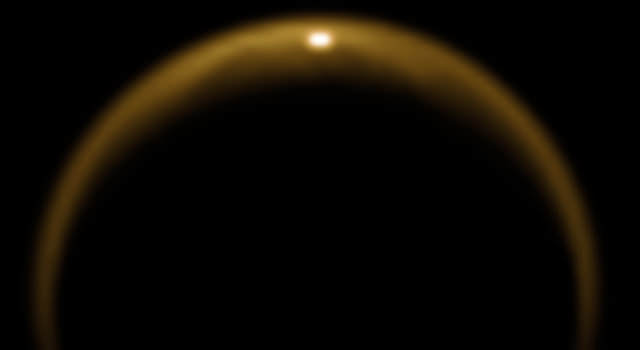This image shows the first flash of sunlight reflected off a lake on Saturn’s moon Titan. Credit: NASA/JPL
Dear friend,
Ah, yes. Another gorgeous day here in the northern lake district. It warmed up to about 94 K (-179 °C, or -290 °F) and we sat and enjoyed the sunshine gleaming off the liquid lakes here on Titan. Wish you were here!
Liquid lakes? Gleaming sunshine? Titan?
Yes, it’s all true. The Cassini Spacecraft has captured the first flash of sunlight reflected off a lake on Saturn’s moon Titan, confirming the presence of liquid on the part of the moon dotted with many large, lake-shaped basins.
Cassini scientists had been looking for the glint, also known as a specular reflection, since the spacecraft began orbiting Saturn in 2004. But Titan’s northern hemisphere, which has more lakes than the southern hemisphere, has been veiled in winter darkness. The sun only began to directly illuminate the northern lakes recently as it approached the equinox of August 2008, the start of spring in the northern hemisphere. Titan’s hazy atmosphere also blocked out reflections of sunlight in most wavelengths. This serendipitous image was captured on July 8, 2009, using Cassini’s visual and infrared mapping spectrometer.
This image is being presented at the fall meeting of the American Geophysical Union in San Francisco.
“This one image communicates so much about Titan — thick atmosphere, surface lakes and an otherworldliness,” said Bob Pappalardo, Cassini project scientist, based at NASA’s Jet Propulsion Laboratory, Pasadena, Calif. “It’s an unsettling combination of strangeness yet similarity to Earth. This picture is one of Cassini’s iconic images.”
Titan, Saturn’s largest moon, has captivated scientists because of its many similarities to Earth. Scientists have theorized for 20 years that Titan’s cold surface hosts seas or lakes of liquid hydrocarbons, making it the only other planetary body besides Earth believed to harbor liquid on its surface. While data from Cassini have not indicated any vast seas, they have revealed large lakes near Titan’s north and south poles.
In 2008, Cassini scientists using infrared data confirmed the presence of liquid in Ontario Lacus, the largest lake in Titan’s southern hemisphere. But they were still looking for the smoking gun to confirm liquid in the northern hemisphere, where lakes are also larger.
Katrin Stephan, of the German Aerospace Center (DLR) in Berlin, an associate member of the Cassini visual and infrared mapping spectrometer team, was processing the initial image and was the first to see the glint on July 10th.
“I was instantly excited because the glint reminded me of an image of our own planet taken from orbit around Earth, showing a reflection of sunlight on an ocean,” Stephan said. “But we also had to do more work to make sure the glint we were seeing wasn’t lightning or an erupting volcano.”
Team members at the University of Arizona, Tucson, processed the image further, and scientists were able to compare the new image to radar and near-infrared-light images acquired from 2006 to 2008.
They were able to correlate the reflection to the southern shoreline of a lake called Kraken Mare. The sprawling Kraken Mare covers about 400,000 square kilometers (150,000 square miles), an area larger than the Caspian Sea, the largest lake on Earth. It is located around 71 degrees north latitude and 337 degrees west latitude.
The finding shows that the shoreline of Kraken Mare has been stable over the last three years and that Titan has an ongoing hydrological cycle that brings liquids to the surface, said Ralf Jaumann, a visual and infrared mapping spectrometer team member who leads the scientists at the DLR who work on Cassini. Of course, in this case, the liquid in the hydrological cycle is methane rather than water, as it is on Earth.
“These results remind us how unique Titan is in the solar system,” Jaumann said. “But they also show us that liquid has a universal power to shape geological surfaces in the same way, no matter what the liquid is.”
Source: JPL


Fantastic! We need to get robotic probes to the surface of Titan, Enceladus, and Europa ASAP. Great article, Nancy, but one correction. In the third paragraph, I think you meant Titan’s northern hemisphere, which has more lakes than the Southern hemisphere, rather than Saturn.
Simply amazing!! What are the chances of life existing in that environment?
@flogger11:
See the article and comments, particularly Lawrence Crowell’s, further down the page for an overview in answer to your question.
The probability for life is pretty small, not zero, but darn small I would think. Life on Titan might have chemistry similar to petrochemistry. Living organisms might be made of compounds similar to what we call plastics. The problem of course is we have absolutely no information of alternative biochemistries, which includes silicon life. So a definative answer is not possible.
However, things are awfully cold there. There is not a lot of energy flow through either. So I would suspect that life is very unlikely.
LC
Life might exist there in unthinkable and unimaginable forms.
Also, I doubt that robotic missions will be a clever contribution to solve the riddles. Or how often, for example, did we consider to send robotic probes into the tropical rainforests for to find new species there?
The only way to get satisfying answers about the exact conditions of possible biotopes outside of our home planet is to establish our own presence in a close-up range.
Awesome